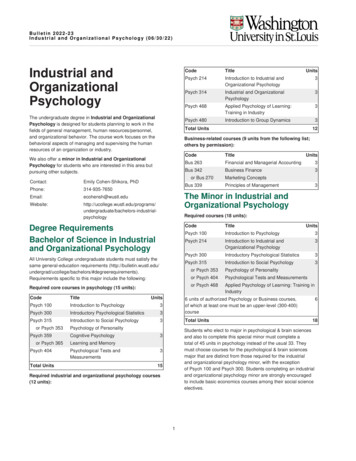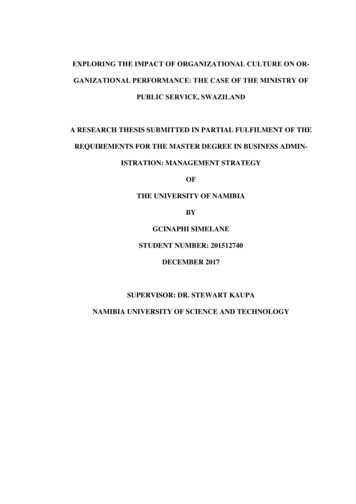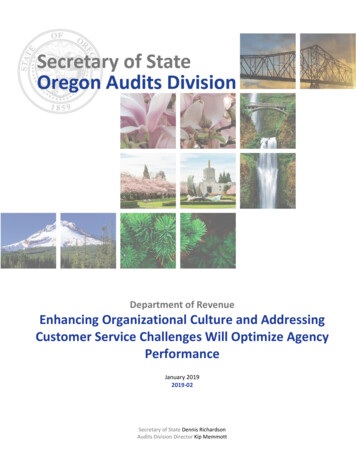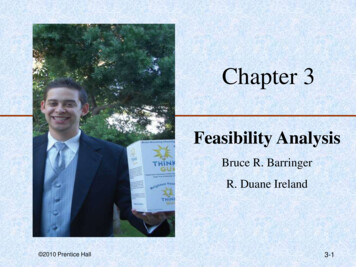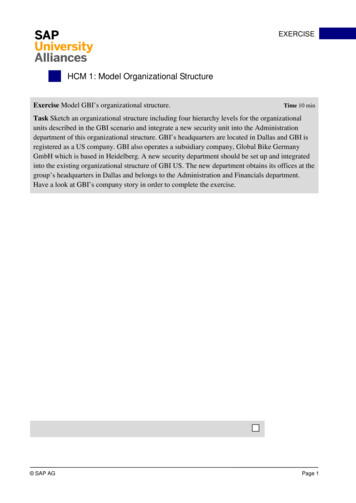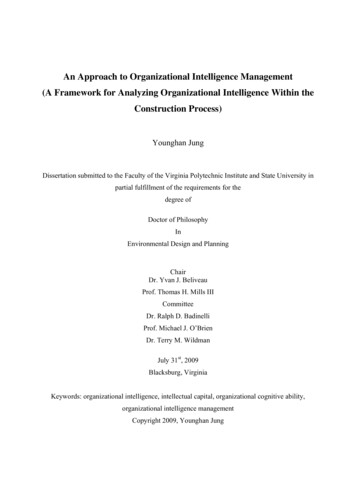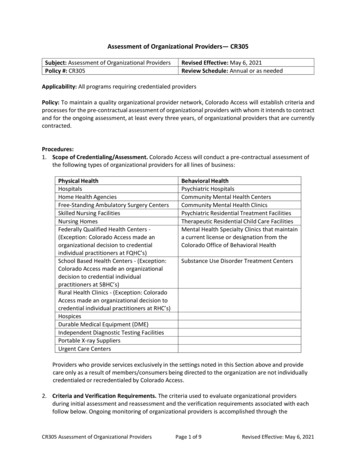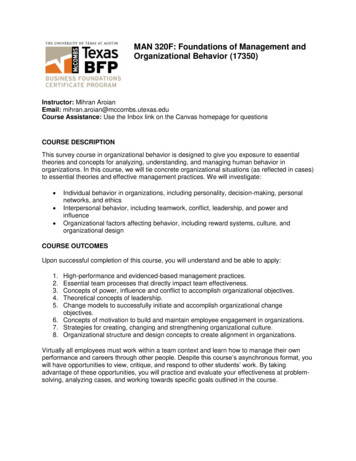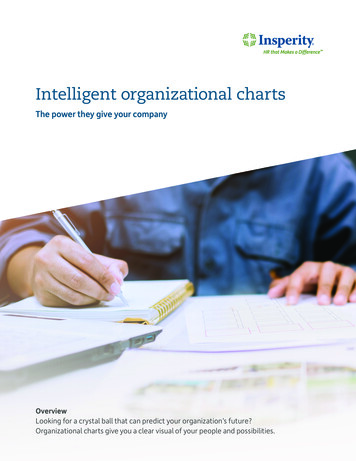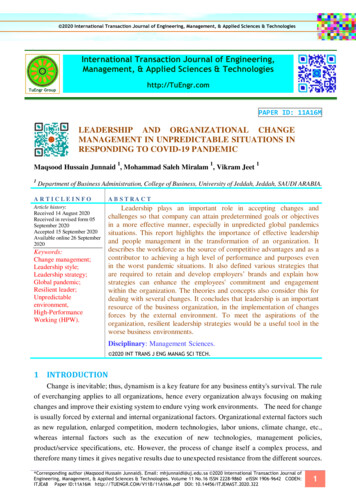
Transcription
Environmental, Social and Governance (ESG)Integration and Organizational ChangeA multi-case study of investment companiesCarlos Pérez BáezMarie-Amelie RemondMain field of study – Leadership and OrganizationDegree of Master of Arts (60 Credits) with a Major in Leadership and OrganizationMaster Thesis with a focus on Leadership and Organization for Sustainability (OL646E), 15 creditsSpring 2022Supervisor: Helgi-Valur Fridriksson
Title: Environmental, Social, Governance (ESG) Integration and Organizational Change. A multi-casestudy of investment companiesAuthors: Carlos Perez Baez and Marie-Amelie RemondMain field of study: Leadership and OrganizationUniversity: Malmö UniversitySubject: Master Thesis with a focus on Leadership and Organization for Sustainability (OL646E)Period: Spring 2022Supervisor: Helgi-Valur Fridriksson2
AbstractEnvironmental, Social and Governance (ESG) data has been seen as a tool to implement Sustainability ininvestment companies. This non-financial data has brought along new type of information into the investmentprocess, resulting in a profound transformation for companies. In order to adapt to the new realities of climatechange and social challenges, companies must understand that changes in organization processes are essential toaddress the outcomes that ESG data will bring. Organizational changes are often caused by internal and externalfactors, allowing organizations to develop new processes and results that can influence the adoption of a neworganizational culture approach. This study analyzes the essential organizational changes in terms of structure andculture. The authors used a multi-case study of two Asset management companies and an external group of expertsto do so. The case analysis was conducted through a qualitative content analysis based on semi-structuredinterviews with nine employees and two external experts within the Asset Management industry. The study resultsshow that ESG plays a vital role in organizational development, forcing structural changes and a new approachtoward organizational culture in Asset Management companies.Keywords: ESG integration, investment decision making, asset management, innovation, change, organizationalchange, organizational culture3
AcknowledgementsWe would like first to thank all the interviewees who have been instrumental for their insights in this qualitativestudy. They have all been very nice to us. We thank them also for their time despite sometimes some urgent workmatters.We would like to thank in particular our two gatekeepers from Company A and Company B, Mr. C and Mr. Lalso for helping us to navigate in your organization and thanks for your time before the interview process as well.Also, we would thank our two proofreaders Maria Skou Andersen and Sofia Lindgren Cortes for your kindsupport.We would also like to thank our supervision professor Helgi-Valur Fridriksson for his support and valuable advice.4
TABLE OF CONTENTSAbstract31. Introduction81.1 Background81.1.1 The investment management industry and sustainability81.1.2 Environmental, Social and Governance (ESG)81.1.3 The culture of asset management companies101.1.4 Pressure from Clients & Regulators101.2 Previous literature review111.3 Research problem131.4 Aim of Thesis141.5 Research questions (RQ)141.6 Layout142. Theoretical framework2.1 Organizational culture15152.1.1 The Competing Value framework162.1.2 The five stages of organizational learning.182.2 Theory of Change192.2.1 Models of Change202.2.2 Climate Change & Regulations force changes222.3 Connecting Theory of change and Competing value framework3. Methods22243.1 Design243.2 Data Collection253.2.1 Interviews253.2.2 Supporting documents273.3 Data Analysis283.4 Reliability and Validity283.6 Limitations293.7 Ethical considerations304. Presentation of the object of study315. Results325.1 Empirical data results325.2 Organizational culture matter: The right CVF for progressing in ESG integration325.2.1 The Competing Value framework (CVF) in action325.2.2 The importance of the organizational culture versus individuals335.2.3 The power of the subcultures within the same organization335
5.3 How has ESG integration changed organizations?345.3.1 Organizational Structure345.3.2 Internal and external communication355.3.3 Change versus external stakeholders: Pressure from Regulator and Competitors365.3.4 Innovation375.3.5 Investment process in change375.4 Responses to organizational changes: Collaboration and prevention of tensions.385.4.1 Internal collaboration within the firm within various teams385.4.2 Traditional platforms of discussion are privileged and strengthened385.4.3 External collaboration with peers through engagement395.4.4 Tensions between people and tensions between non-financial data and numbers395.5 Others significant findings405.5.1 The psychological contract405.5.2 Emotional findings406. Analysis and Discussion416.1 Discussion on what type of organizational culture according to the CVF fosters ESG integration416.2 Discussion on organizational changes influenced by ESG integration426.3 Other discussions436.4 Limitations467. Conclusion47List of references49Appendix 154Appendix 2 - Example of Interview - Company A - Interviewee : CIO556
List of TablesTable 1 - Example of ESG factors. Source UNPRI.Table 2 : Investment process with ESG integration: a triangle collaborationTable 3 - The three levels of culture - based on Schein (1997).Table 4 - The Competing value framework (Quinn and Cameron 1999)Table 5 - The five stages of learning from ZadekTable 6 - Adaptation to Outcome-based Approach framework (Allen et al. 2016, page 958)Table 7 - The competing value framework for culture, leadership, effectiveness and value drivers byCameron (2022)Table 8 - List of the intervieweesTable 9 - List of the supporting documentsTable 10 - The CVF resultsTable 11 - Collaboration triangleTable 12 - Adaptation to the CVF based culture transformation (Gong et al.)Table 13 - Company A Organization chartsTable 14 - Company B Organization chartList of abbreviationsAGM Annual General MeetingAI Artificial IntelligenceAMC Asset management companiesCEO Chief executive officerCSR Corporate social responsibleESG Environmental, Social, GovernanceGHG Greenhouse gasICGN International Corporate Governance NetworkOCAI Organizational Culture Assessment InstrumentRI Responsible InvestmentSFDR Sustainable Finance Disclosure RegulationUN United NationsUNPRI United nation Principle responsible investmentsWordcount : 18,0017
1. IntroductionThis thesis explores the organizational and cultural changes in ESG implementation through aqualitative analysis of two asset management companies. Before exploring this topic, it is essential togive some background on the nature of the investment management industry in conjunction withsustainability.1.1 Background1.1.1 The investment management industry and sustainabilityIn light of other sectors, the investment companies known as asset management companies (AMCs)started to look at sustainability as a critical set of opportunities and challenges for businesses aroundsix to ten years ago. In more recent years, AMCs have been accelerating their transformation toward abetter understanding and implementation of Sustainability. In 2019, Deloitte published the followingquote 'as with any era of disruption, climate change is creating and will continue to create risks anddrive opportunities for asset managers' (Deloitte, 2019). Today in 2022, sustainability is becomingmore ‘mainstream’.As significant institutional shareholders in invested companies, AMCs have the power to change theworld by investing in more sustainable securities and also by engaging firms to change. Voting atAnnual General Meetings (AGM) to pressure where their commitment to decarbonization and theenvironment is concerned is one area among regular engagement with the invested companies. Today,representing more than US 100 Trillion of assets, the Asset management industry represents asignificant power to accelerate the ecological transition as they represent the shareholders of thecompanies where they are invested in.1.1.2 Environmental, Social and Governance (ESG)ESG issues were first mentioned in the 2006 United Nations Principles for Responsible Investmentreport consisting of the Freshfield Report and "Who Cares Wins," an article published by the UNSecretary-General and UN Global Compact (UNPRI, 2006). ESG stands for Environmental, Social andGovernance. Those ESG criteria had, for the first time, been required to be incorporated in the financialevaluations of companies. This effort was focused on further developing sustainable investments (UN,2006).Traditionally, investment decisions have been based on financial data to deliver returns for customers.The core of financial data is traditionally (1) balance sheets, (2) income statements, (3) cash flowstatements, and (4) statements of shareholders' equity (Soh, 2019). Those data are extracted fromcompanies' reports and brokers and analysts when forecasts and estimates are necessary to project thethree or five years prospects.To transform Asset management toward sustainability, ESG data (e.g., Table 1 shows ESG factors) ininvestment became crucial. They profoundly changed the investment process through a 'rapidreorientation and restructuring' (Sciarelli et al., 2021). Implementing Sustainability in assets needs ESGdata which provides a framework for considering extra-financial factors in the investment process. Nonfinancial data is defined as ESG-related data and can be found, for example, in companies' reports suchas CSR reports (Soh, 2019). Third-party independent organizations can also collect that data (MSCI,Sustainalytics) and sell it to AMCs.Some researchers call those ESG data 'innovative data' (Soh & Young, 2019). One of the significantchallenges is getting familiar and expert with those new data sets and translating those data into financialopportunities. Also, today, ESG's problems are accessibility, transparency, time, comprehensiveness,rationality, and scarcity. Finally, costs that challenge ESG data integration are complex as they connectthe dots across different disciplines (Soh, 2019).8
Deloitte sees in the ESG space that 'Investors pursuing or considering to pursue ESG integration and insome cases insisting on it' (Deloitte, 2019). Environmental and social related proposals are becomingcentral for most shareholder AGMs where AMCs are participating. Data providers are providing moreESG criteria, adding new ones every month.Examples of environmental, social and governance (ESG) factors. They include:EnvironmentalSocial- Climate change-Human RightsGovernance- Bribery and Corruption- Resource depletion- Modern Slavery- Waste- Child labor- Pollution- Working conditions- Political lobbying and donation-Deforestation- Employee Relation- Tax Strategy- Executive pay- Board diversity and structureTable 1 Examples of ESG factors. Source UNPRIWorth mentioning that the term ‘ESG’ is used by AMCs where other industries are using more genericterms such Sustainability and CSR (Corporate Social Responsible).ESG data did require ESG specialists named as ESG analysts joining the Investment process todayseating with Conventional analysts and fund managers (Table 2).Table 2 : Investment process with ESG integration: a triangle collaborationFew questions may arise as to how AMCs have reacted and implemented this new ESG data input?How have they supported and learned about this new addition? How are they measuring the impact ofthis transformation?9
1.1.3 The culture of asset management companiesIn order to be critical for this study, it is crucial to understand the Asset management culture with a fewkey characteristics as demonstrated by a few reputable consulting firms, such as Willis Towers Watson.Indeed, backed up by a framework, they identified that culture based on a value proposition (fromemployees and clients) overreached by leadership is a powerful ingredient to success in the long run forAMCs (Willis Towers, 2018).Traditionally, AMCs have been identified with a 'star manager' culture with for each fund manager apersonal track record. This culture is galvanized by Top fund manager rankings from media, ratingagencies and clients who need to 'visualize' who is running the investment decisions (Fund Europe,2012). The names of Warren Buffet, Bill Gross, and Peter Fleming have been well identified byinvestors, retail or institutional, as iconic fund managers over the years. Even the name of a few AMCsare associated with their founder who used to be a fund manager like Templeton or Carmignac.However, this type of culture has changed progressively over the last decades, accelerated by the GlobalFinancial Crisis (GFC) with the emergence of stricter compliance regulation which forces AMCs to rethink power and communication to clients and, of course, with more stakeholders' involvement in theinvestment process today. The ‘star manager’ system also has some limitations due to the strong growthof passive investments. We mean by Passive investments, investments who do not use humaninteraction per se but more financial modeling and quantitative duplications of benchmark techniquesor factor investment-based. There is no or little interaction between humans as investment decisionmakers.Asset management companies are driven by financial performance for clients and a culture of riskadjusted returns. Those financial returns are what AMCs are delivering after fees and are usuallycompared to market benchmarks. Those returns have repercussions on profitability but also on how theremunerations and incentives are allocated. A battery of measurements regarding risks and returns byvarious periods, such as annual returns, three years, or five years returns, are used. Of course, goodreturns will attract new clients; poor returns will lose clients. Performance is highly correlated tomanaged assets.The culture of returns is associated with fund managers' performance. Indeed, the fund track recordsshowing one year, three years, and five years returns are common practice, and those fund performancesare associated with one individual. The investment horizon is a key in the asset management culture,managing a paradox between the long-term framework, particularly in the equity market within thefive-year horizon framework, and the communication of annual returns.Like the banking industry, the asset management industry is highly regulated. For the last twenty years,compliance has emerged as a core set of competencies. The regulatory landscape for asset managers inthe aftermath of the GFC, such as investor protection, code of conduct, sustainable investing, capitalmarkets, and financial stability, has been strengthened in the EU 2019 (Schroder, 2019). Indeed, conflictof interest, bribery, and money laundering are just a few examples of risks AMCs face every day. As aresult, AMCs have been forced to reorganize structures with new governance at the board level and insenior management and, of course, in additional skill sets, which has impacted the profitability of theAMCs in general. This strong regulation may also affect the way organizations are changing.1.1.4 Pressure from Clients & RegulatorsPressure from clients, mainly Institutional clients such as Pension Funds and media, and regulation,have pressured AMCs to change toward a more sustainable way of investing. In Europe, regulation has10
been recently very active within 2021 for the first time, a global EU taxonomy regulation trying to setup a common language in the EU by a precise terminology and trying to prevent greenwashing. Newterms such as Article 8 or Article 9 funds have flourished recently within the investors' community. Inaddition to the EU Taxonomy, a Sustainable Finance Disclosure Regulation (SFDR) is part of anambitious legislative framework that will significantly shape sustainable investing.On top of that, to anticipate and address this regulatory change, Asset management has seen aproliferation of industry initiatives. Such initiatives include CDP (Carbon Disclosure Project), ClimateAction 100 , ICGN (International Corporate Governance Network), and recently the Net Zero Assetmanager initiative or Finance for biodiversity initiative, to name a few.1.2 Previous literature reviewResearch into ESG integration in asset management companies has gone through different paths duringthe last few years. Some of the primary focused research in the field of ESG integration has been relatedto risk management and understanding what can be the best use of this new set of data in the investmentprocess (Van Duuren & Plantinga, 2015; Eccles et al., 2017; Soh Young, Rook & Monk 2019; YoungFerris & Roberts, 2021). Previous research points out that most of the attention has focused on howESG can become an integration process to better equip companies' financial outcomes. A lack ofunderstanding about how ESG data is transforming the organizational structure has not been yetcarefully addressed (Sciarelli, Cosimato & Landi, 2020). Further research has expanded the barrierslimiting ESG integration into organizations; such researchers have found a matter of costs, lacks detailand is difficult to quantify (Amel-Zadeh & Serafeim, 2018, Eccles et al., 2017, Young-Ferris & Roberts,2021). One of the main gaps in the literature is the effects on organizational structure, which can be afactor in how companies can efficiently implement ESG data. Sciarelli, Cosimato and Landi (2020)present some exciting insights that point to how the company is responsible for managing these criteriabest. In order to best integrate ESG into their socially responsible investment (SRI) policy; therefore,organizations should allow organizational restructure to best handle this (Sciarelli, Cosimato & Landi,2020).The purpose of ESGIn a case study by Young-Ferris & Roberts 2021 called "'Looking for Something that is not There': ACase Study of an Early Attempt at ESG Integration in Investment Decision Making," the finding of thispaper give some insight into the limitations of real integration of ESG into investment decision making,arguing that investors should consider ESG issues, not for ethical reasons, but rather because they arefinancially material has proved particularly effective in getting more and more investors to commit tothe Principles of Responsible Finance (PRI) (Young-Ferris & Roberts, 2021). The challenge is that ifdone correctly and responsibly with total transparency and ethics, ESG integration can be imagined andpresented as something of an ethical and profitable revolution in investment practice.The paper addresses organizational culture as 'the question concerns not only the data but how this fitswith the prevalent' systems of expertise, social relations, and cultural narratives in which the data isused' (Young-Ferris & Roberts, 2021). This paper articulates three steps for ESG integration: 1 Am Ilooking for something that is not there? 2 Changing Data providers 3 You have got masses of data Icannot handle, with the topic of how to build ESG data platforms. The articles provide insights onorganizational changes or innovation by mentioning the need for IT people who can allow the analyststo be efficient in their Decision Making. Also, the paper identifies the issue of translation that AMCs11
are faced with in seeking to calculate the financial materiality they should attach to their new ESG data(Young-Ferris & Roberts, 2021).Change in purposeVan Duuren and Plantinga (2015) argues that ESG is a reinvention of Fundamental Investing. In thequantitative research named ‘ESG Integration and the Investment Management Process: FundamentalInvesting Reinvented’ by Van Duuren & Plantinga 2015, the authors mainly identify how the fundmanagers used ESG in their investment processes. By looking into the main financial target, they canuse the data to leverage returns and avoid risk. These measures were risk management and performancelevels, both short and long, in the different portfolios that use ESG integration in the investment processas a helpful resource. Later on, Young-Ferris and Roberts( 2021) stated that ESG issues have provedparticularly effective in profitability, not for ethical reasons but financially material (Young-Ferris &Roberts, 2021). Concerning the ESG dimensions, the most substantial focus is on the firm's governance,which has a close relationship with the quality of management that companies have. The method useda quantitative research method involving 1,000 fund managers. Three findings are; first, conventionalFund managers have adopted ESG; second, ESG resembles fundamental investing; and last, thedomicile of the portfolio managers has a distinct impact on Responsible Investment.Barriers to ESG integrationESG integration in investment decision-making was presented in an article by Eccles et al. named "Howto Integrate ESG into Investment Decision-Making" (Eccles et al., 2017). The method used in thisacademic article is a quantitative study of 585 investors. This article is probably one of the first attemptsto understand some of the fundamental approaches needed when dealing with a new set of data byproviding actions required to analyze better ESG, which was further elaborated by Amel-Zadeh, A.&Serafeim G. 2018. The main findings were related to how ESG integration 'gives a promise of newthinking'; they explore the barriers to ESG integration: fear of underperformance, concerns aboutfiduciary duty, and, more importantly, lack of quality data. According to Eccles et al. 2017, the scarcityof high-quality ESG data is the main barrier to good integration (Eccles et al., 2017). Further on, AmelZadeh and Serafeim (2018) elaborate on the limitations of ESG in investing companies pointing outthat the quality and usability of data is a common obstacle for companies.Limitation of ESG integrationIn order to understand the limitations on ESG integration in investing companies, it is relevant for thestudy to find what type of barriers are being found in mainstream investing companies. The article byAmel-Zadeh & Serafeim (2018), "Why and How Investors Use ESG Information: Evidence from aGlobal Survey," based on a quantitative study using survey data, shows that companies think that ESGinformation is costly to gather and analyze, lacks detail, and is difficult to quantify. These findings makea clear connection to what was previously stated by Eccles et al., 2017 regarding the scarcity of highquality ESG data. Moreover, findings suggested that the reporting of ESG data is too cluttered to beuseful or that their client mandates legally prevent them from incorporating ESG information (AmelZadeh & Serafeim, 2018). Lastly, the researchers found that a lack of standardization and quantificationare the main obstacles to ESG data integration which later on was discussed by Soh Young In, Rook &Monk, 2019. Further in this article, the authors argue how data tech has improved accessibility,availability, and transparency, but the theoretical framework is still missing (Amel-Zadeh & Serafeim,2018).The quality of the ESG DataBecause the problem of quality data has already been pointed out by Eccles et al. 2017 & Amel-Zadeh& Serafeim, further research about integrating ESG data in investment decision-making was needed.12
Another article exploring the data's limitations is an article written by Soh Young In, Rook & Monk2019, "Integrating Alternative Data (also known as ESG Data) in Investment Decision Making,"' wherethe findings offer a 'user-oriented approach' perspective. According to the authors, investment decisionmaking is how to choose and use ESG data, where the researchers identified six dimensions of ESGdata limitations. These are described as 1-reliability, 2-granularity, 3-freshness 4-comprehensiveness 5actionability, 6-scarcity, and six dominant variables used by investors in their decision-making(conventional risk, unconventional risks, cost, commitment, influence, and construction). Even thoughthis qualitative study presents some limitations in terms of data previously mentioned by researchers(Eccles et al., 2017; Amel-Zadeh & Serafeim, 2018; Soh Young In, Rook & Monk, 2019), a lack ofunderstanding of the organizational perspective concerning ESG integration is missing. The researcherwas focused on questioning data sources and data rating agencies in terms of the dimensions. Thelimitations see no interconnection on how this impacts the organization regarding structure, culture, andforced changes in the investment decision-making processes.Organizational structures as a tool to support ESG integrationIn a multi-case study by Sciarelli, Cosimato & Landi 2020, "Socially responsible investment strategiesfor the transition towards sustainable development: the importance of integrating and communicatingESG," they research how companies differently integrated ESG into their Sustainable ResponsibleInvesting (SRI). This article perhaps provides some insight on the outcomes of how organizationalstructure can be beneficial in terms of accessing ESG data. Thus, if some organizations are pretty nearto full integration, the others demonstrate a minor than a total commitment to ESG. This seems to bemainly due to the different approaches that asset management companies (AMCs) and managers haveadopted ESG integrating criteria which are: (1) longevity, (2) portfolio characteristics, (3) fundscharacteristics, (4) SRI strategy, (5) rating and (6) financial markets (Sciarelli, Cosimato & Landi 2020).The authors conclude that each company is responsible for best managing these criteria to integrateESG into their SRI policy; therefore, organizations should allow organizational restructure to besthandle this.1.3 Research problemThe research problem is how AMCs are organized well enough to integrate ESG better, cost-effective,and faster. How can they change their organization toward a more aggressive ESG integration, as thereis today, by all literature, a sense of emergency (2030 targets)? The problem of integration has beenrecurrent for organizations in this industry, and greenwashing, which is a reflection of a specificcomplacency, has been identified by the regulators (at least in the European Union and some othercountries), more demanding clients on this matter and the industry itself as a fundamental problem totackle (Posi & Sethi, 2019). Therefore there is a gap in the research regarding how ESG changesorganizations from a cultural and structural perspective. Our research seeks to cover that current gap inresearch. The question concerns the data and how this ‘fits with the prevalent ‘systems of expertise,social relations, and cultural narratives in which the data is used’ (Young-Ferris, 2021).13
1.4 Aim of ThesisThe targeted audience for this thesis are AMCs who have already implemented ESG data in theinvestment process, Asset Managements that are lacking ESG implementation and independentconsultants within the ESG expertise.The aim of this thesis is to identify and analyze how organizational changes are perceived dueto ESG integration in asset management companies.1.5 Research questions (RQ) RQ1: How has ESG integration changed asset management companies?The purpose of this RQ is to gather information about the participants' perception of how ESGintegration has changed the companies in terms of structure and investment process by three angles: theduration (shorter or longer), the complexity (more or less) and the process (more or less formal). RQ2: How do employees and companies respond to the organizational changes caused by ESGintegration?The purpose of the RQ is to understand how the participants have responded to ESG integration withintheir company, and what are the impacts behind vision and strategy. RQ3: How has ESG integration been a driver for sustainability-oriented innovation in assetmanagement companies?The purpose of this RQ is to understand how ESG integration has pushed AMCs to respond toinnovation as ESG data is considered innovative data. One way to measure innovation is the number ofnew products launched and by interviewing product heads, we could have a good understanding of howthe ESG data have contributed. RQ4: What kind of culture attributes are crucial for ESG integration in the Asset Managementcompanies?This RQ aims to identify and evaluate what culture contributes to facilitating ESG integration moreefficiently. This thesis uses the CVF to identify which culture is predominant. In order to answer theresearch questions, the aim is to interview participants in high-ranking positions at asset managementcompanies who have already established ESG integration at the Managerial level according to Zadek'sfive ladders of organizational learning. (Zadek, 2004).1.6 LayoutThis thesis is structured into six chapters. Firstly, a literature review provides insights into the maintopics and their current state of research. Then, the next chapter presents an articulated definition oftheories used in this paper and how they are related to the research question. The next chapter illustratesthe methodology and research design, including the limitations and validity of the study. Section fourpresents the research findings from the case study and interviews through qualitative content analysiswith quantitative components. Afterward, these findings are discussed, and the study's implications aredemonstrated in a framework. Lastly, the paper is rounded off with conclusive thoughts and futureresearch recommendations.14
2. Theoretical frameworkIn order to answer our research questions, a theoretical framework has been identified to address a fewareas, such as organizational culture and organizational change. The theory of change (ToC) is to guidethe empirical study. Previous research demonstrates a lack of understanding of how ESG integrationimpacts organizational culture and struc
Berrio (2003), the framework authors have created an "Organizational Culture Assessment Instrument . 17 (OCAI)," which is used to identify the organizational culture profile based on the core values, assumptions, interpretations, and approaches that characterize organizations (Cameron & Quinn, 1999). . ability_is_important_in_the_Asset .
